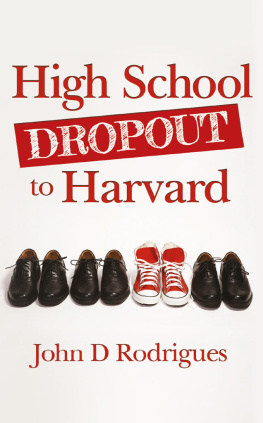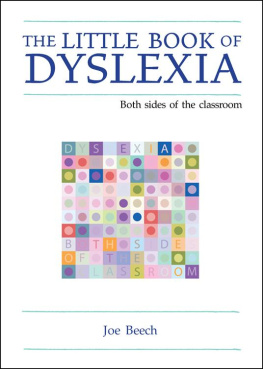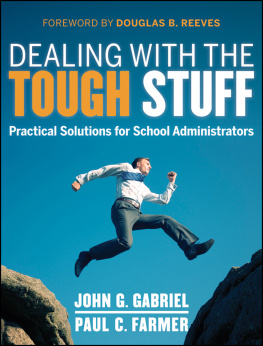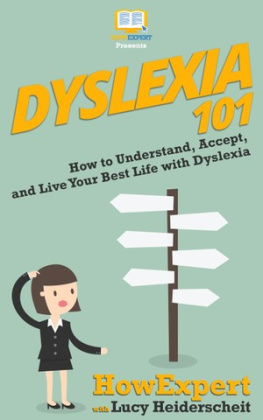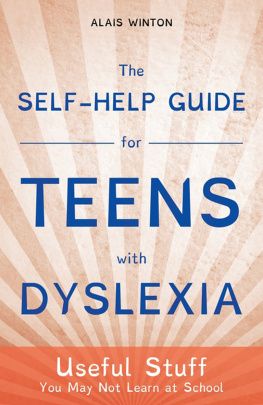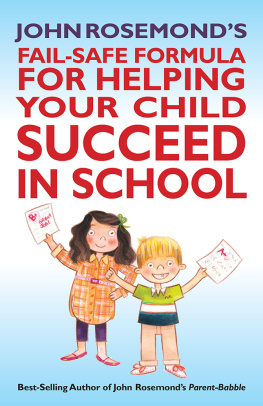High School Dropout
to Harvard
John D Rodrigues
Copyright 2013, John D Rodrigues
All rights reserved. No part of this book may be reproduced, scanned, or distributed in any print or electronic form without permission. Please do not participate in or encourage piracy of copyrighted materials in violation of the authors rights. Purchase only authorized editions.
ISBN: 0615579116
ISBN-13: 9780615579115
For Julia
Table of Contents
Freak Shoes
W ith my undiagnosed dyslexia, my growing self-doubt, and the lack of sympathy from my family, it is no wonder God thought it best that I have warped feet. My feet curved inward, bad enough that others noticed it when I walked. But it was worst whenever I ran in a game of freeze tag or soccermy feet would often hit the back of my leg when they were coming around to make the next step. I was an awkward sight to see. My parents took me to the doctor, who prescribed me a pair of orthopedic shoes. After prolonged use, these were supposed to straighten the curve in my feet. They were as stylish as orthopedic shoes can be. Surely these shoes would help me blend in with my classmates. The boots were made of rough brown leather, had thick soles, laced up over my ankles, and were lined with metal. They were heavy and they hurt to wear. I looked at the soft rubber soled tennis shoes of normal kids with longing. Naturally, my classmates were discreet and open-minded about my monster shoes.
Hey, Frankenstein. Go away freak shoes! As if things werent bad for me already. I couldnt keep up with other kids in class because of my dyslexia. I was forced to sit still in silence for most of the day, which I hated. I slurred my words when I got nervous, and now to top it all off, I had to wear these huge freak shoes. Thank you, world. I remember standing apart from other kids on the playground. One day two little girls came around from behind me as we were walking toward the playground for recess. One said, Whats wrong with your feet? and the other added, You walk funny. I was crushed. Those mean second graders. What could I say? And what is it about children pointing out the obvious that makes the words hurt so much? I knew I walked funny, thats why I was wearing these shoes. But I said nothing. I couldnt explain to those two girls that my mothers womb had been crowded and that my feet were pressed against her stomach while I was growing inside her, causing my deformity.
I started getting in trouble for things I could not help. In third grade I had Mrs. Garhart as my teacher. Pretend your bottom is glued to that chair, she said. What a terrible image. She looked down at me as she hovered over my desk. Good children sit still, she announced in her shrill voice. She had a punishment for everything. If I wasnt writing lines for talking in class, I was walking the track during lunch for not sitting still. Report cards came out and in the Additional Comments section she wrote in neat cursive: restless, talks to much, needs to improve classroom behavior. So many categories had check marks under the Unsatisfactory column. When my parents read the report card I was punished at home for the behavior that had been punished at school. My life wasnt looking any better until that day.
Little did I know that morning, as I strapped on my shoes, pulled on my jacket, ready to face another day as a bottom dweller, that my life was about to change. It was the day our third grade class was taken out to one of the schools baseball fields to learn a game called kickball. The game is played a lot like baseball, but instead of a baseball and bat, you use a rubbery red ball. The game is fairly straightforward. The ball is rolled to you and you kick it as far as you can, then run to the bases and hope that nobody catches the ball or tags you out. Our P.E teacher instructed us on the basics of the game as we all sat on the grass on a perfectly bright spring day. I loved P.E. class because it meant that I did not have to sit still. Here I could run around as much as I wanted. Our class was divided into two teams. Halfway through the first inning, kickball quickly became a game our whole class loved. Everyone was yelling and cheering when someone on their team kicked the ball and ran for first base. My team started the game in the outfield and it wasnt until a couple innings later that I got a chance to kick that red ball. I must have been quite a sight as I stood over home base, a scrawny kid in bulky shoes. I was hoping to get a good kick between the fielders and to make it in time to reach first base. I knew this would be difficult, because my shoes made me clumsy. Or perhaps they just enhanced my natural clumsiness. I would have to run as fast as I could.
The pitcher rolled the ball in a straight line towards me. I ran over to it and kicked it with all of my might. The rest is a blur. As I kicked the ball, it soared high into the air, and kept going, higher and higher, past the infielders. By the time it got to the outfielders, the ball was so high in the air that all they could do was watch as the ball sailed over their heads. The ball went so far that it landed on another playground on the other side of the field and rolled into a sandbox. It was an amazing kick that left our whole team jumping up and down and cheering as I ran around the bases and all of our base runners came home to more cheers and high-fives. Even some of the other teams members were jumping up and cheering for my long kick. By the time the outfielders had retrieved the red ball it had taken so long that some of the fielders were sitting down on the grass waiting. Apparently, winning a game is all thats needed to make you an instant hero. From that day forward, whenever we played kickball, kids would always pick me first. If my life were a movie, then at the end of the day I would discover that there had in fact been no metal in my shoes that day and that it had been me all along. Enter triumphant music . Fade to black . Alas, my life was not a movie. But it didnt matter to me.
Blame it on performance-enhancing orthopedics, but this one moment changed the course of elementary school life. I dont think anyone knew that inside my prescription boots there lay a series of metal bars, which granted me the ability to out-kick every boy in my class. After that momentous day, kids stopped teasing me about how I walked and instead began to regard me as one of the class athletes. Talk about social climbing. I would continue to wear the special shoes for two more years. Each year the shoes got smaller and less noticeable. Soon the day came when I would wear them no more. Without the weight of my shoes my feet felt light on the ground. I remember my overwhelming joy at being able to run, unimpeded at last. I was free.
This newfound love would earn me a peculiar distinction in 6th grade. Our school held a charity running event called a Jog-A-Thon in which students had family and friends sponsor us, committing a donation for each lap we would finish . Since I no longer wore my special shoes, I was a fast runner. I had so much fun running that I ran more laps than anyone else in the entire school. So much that I was honored by the principal with a plaque and I received a special award in the form of a donated chin-strap from the Los Angeles Rams football star Jim Youngblood. Looking back on this, it was a strange award to receive but at the time it felt like the best day of my young life.
While it may look silly to recount these isolated events of my childhood, I believe these moments changed the way I think about weakness. In line with the idea of three-dimensional thinking, it is a useful exercise to think about whether your particular weakness has a dimension that you have not discovered. In my youth I considered my freak shoes a weakness, but they had another side to them that could be converted into strength. Likewise, dyslexia is considered a weakness or impediment. Indeed, people with dyslexia are protected under disability laws, in part because learning disabilities impede major life activities (like reading). But I think of dyslexia as a consequence of three-dimensional thinking, which itself can be a strength if properly harnessed. This is why I tell people with learning disabilities (or anyone) to focus on their strengths. People tend to focus on our weaknesses. Some weaknesses will always be weaknesses. No one is going to cure your dyslexia. But you can change the way you approach it and I believe this is the formula followed by successful thinkers, innovators, and entrepreneurs who also happen to be dyslexic.
Next page
